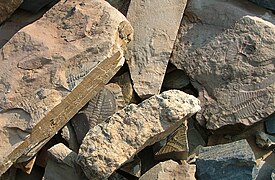Mount Stephen trilobite beds
The Mount Stephen trilobite beds (literally translated: Mount Stephen Trilobitenschichten ), also Ogygopsis Shale (Ogygopsis schists called) are a series of layers of fine-grained fossil leading sedimentary rocks of Mittelkambriums of North America . They occur at around 2,130 meters above sea level on the western flank of Mount Stephen in the northern Rocky Mountains in the southwest of the Canadian province of British Columbia . This place is also known as USNM locality 14s . The exact geological conditions there are unclear due to faults and landslides and it is not known whether or where the Mount Stephen trilobite beds are actually present .
history
The first fossil finds in the Mount Stephen trilobite beds were made during the construction of the Canadian transcontinental railway (see Canadian Pacific Railway ) in the 1880s and subsequently published by various authors. These finds had a particular influence on the American paleontologist Charles Walcott , who carried out collections on Mount Stephen in 1907 and tried to understand the local geology. Walcott's interest in the region, awakened by the “ Ogygopsis Shale”, ultimately led to the discovery of the famous “Phyllopod bed” on Fossil Ridge between Wapta Mountain and Mount Field on the other side of the Kicking Horse River valley in 1909 .
stratigraphy
The Mount Stephen trilobite beds are stratigraphically placed in the deeper part of the Burgess Slate Formation (formerly also called the "mighty" Stephen Formation) at the base of the Campsite Cliff Slate. There they discordantly overlay the Yoho River limestone, the second oldest layer member of the Burgess slate formation. The Mount Stephen trilobite beds are therefore somewhat older than the "Phyllopod bed".
fauna

|

|
|
|
Left: Mudstone slabs with trilobites (probably all Ogygopsis klotzi ) from the Trilobite beds. The pieces are not brought together, the rock is actually so rich in fossils.
Right: Largely complete exuvia (the free cheeks are missing) of Ogygopsis klotzi from the Trilobite beds. |
||
The Mount Stephen trilobite beds, made of silty clay stones , form a typical Burgess Shale-type conservation deposit. It is named after the extraordinarily high number of trilobites , often very well and very completely preserved , especially those of the genus Ogygopsis . In addition, these layers include shells of lingulaten and rhynchonelliden brachiopods and remains of typical Cambrian forms without heavily mineralized exoskeletons, like the sponge -like Chancelloria , the alleged Scyphozoenpolyp Byronia and head attachments ( "claw") of the enigmatic primal elements animal Anomalocaris . The first description of numerous Cambrian taxa , including Anomalocaris , was based on specimens from the Trilobite beds.
swell
General
- Dave Rudkin: The Mount Stephen trilobite beds. Pp. 91-102 in Jean-Bernard Caron, Dave Rudkin (Eds.): A Burgess Shale Primer - History, Geology and Research Highlights. Charles D. Walcott & the Discovery of the Burgess Shale - International conference on the Cambrian explosion (ICCE, August 3-8th, 2009: Banff, Alberta, Canada) Field Trip Companion Volume. The Burgess Shale Consortium, Toronto 2009, ISBN 978-0-9812885-0-5 ( PDF 33.5 MB, complete excursion guide).
- Terence P. Fletcher, Desmond Collins: Geology and stratigraphy of the Burgess Shale Formation on Mount Stephen and Fossil Ridge. Pp. 33-54 in Jean-Bernard Caron, Dave Rudkin (Eds.): A Burgess Shale Primer - History, Geology and Research Highlights. (For further bibliographic information see above).
Individual evidence
- ↑ for example from scyphozoan polyps of the genus Cambrorhytium (" Selkirkia "), see Simon Conway Morris, RA Robison: More soft-bodied animals and algae from the Middle Cambrian of Utah and British Columbia. University of Kansas Paleontological Contributions. No. 122, 1988 ( PDF 5.8 MB), p. 18 ff.
Web links
- A visit to the Burgess Shale - July 2001 - Geotouristic travelogue with many photos
- Mount Stephen Trilobite Beds - Burgess Shale Geoscience Foundation's geotourist information site

